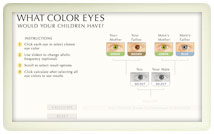Community Embraces New Word Game at Mid-Year Play Day This past Sunday, families at Takoma Park’s Seventh Annual Mid-Year Play Day had the opportunity to experience OtherWordly for the first time. Our educational language game drew curious children and parents to our table throughout the afternoon. Words in Space Several children gathered around our iPads […]
Read moreIncorporating intuitive graphs provides visitors with new insights.
  |
Problem
You need to explain the relationship between two variables, where one variable dependent on the other variable, and the values are continuous, such as the speed of a horse running around a track or the times in different time zones.
Solution
The following three methods all detail the boiling point of water:
- Normal graph: The x-axis is the independent variable and the y-axis is the dependent variable. In this case, the x-axis is the height above sea level, and the y-axis is the boiling point of water.
- Animate values with an abstracted scale: In this case, the visitor moves a knob to select different elevations, and another knob animates in real time to show the corresponding boiling points.
- Animate values with a realistic scale: In this case, the visitor moves a small icon of a person up and down a mountain. In real time, a ruler scale adjusts to show the current height, an animated thermometer shows the boiling point of water, and an animated timer shows how the baking time varies for cookies.
Discussion
Although a normal line graph actually shows the most information, with the boiling points for all elevations shown simultaneously, line graphs are not intuitive for most users. Animated values with an abstracted scale provides the information while making learning more interesting and fun. Using animated values with a realistic scale, the visitor has the sensation of discovery, as if they are personally climbing the mountain to conduct the experiment. Additionally, you can add contextual information in your illustration, such as nature of the terrain at different elevations. By coloring the figure, the visitor better intuits the difference between a desert-like climate below sea level, and the thin cold air at alpine heights.
Visual examination of graphs helps visitors acquire insight into the complex relations embodied in a model. This technique helps reduce the number of dimensions of data you are showing. Rather than show a two-dimensional graph of elevation vs. boiling point, you show only one dimension (elevation), and one boiling point at a time.
It can be difficult to illustrate three-dimensional data, such as elevation vs. time vs. temperature of cake batter. However, by separating elevation and animating it, you can display a line graph of time vs. batter temperature, and visitors will understand that it takes longer to cook a cake at high elevations because the batter heats more slowly.

